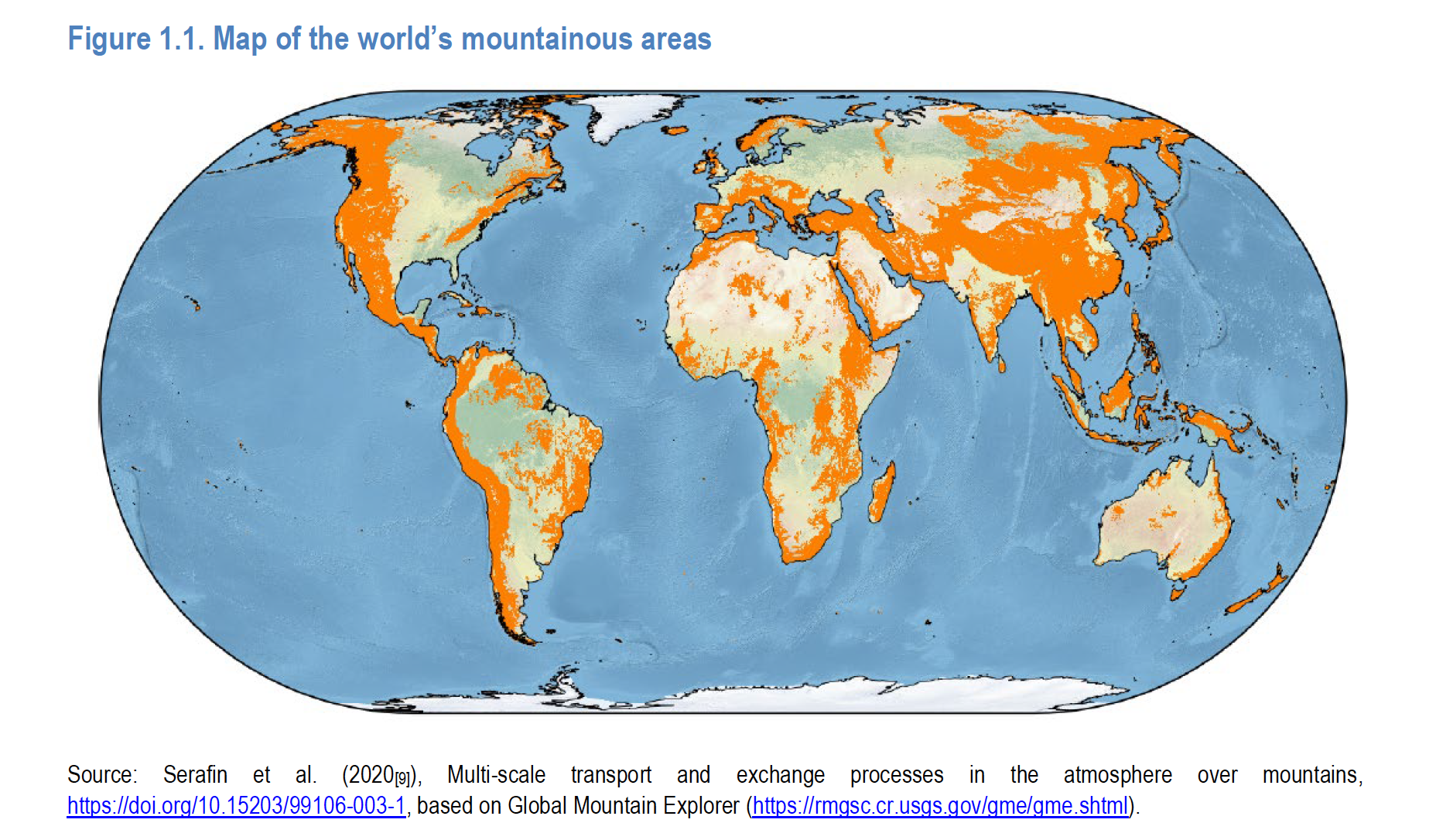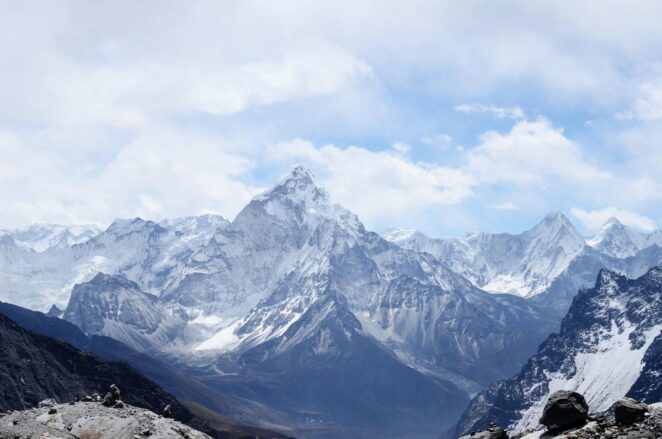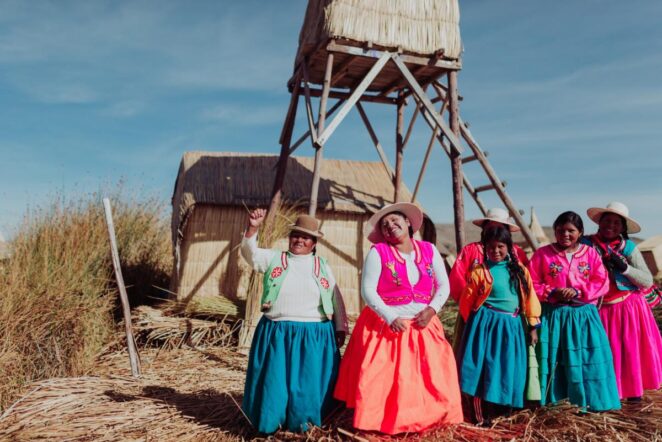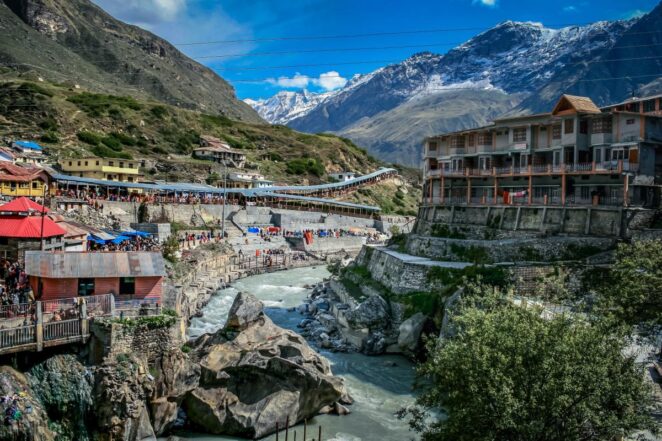Strengthening Climate Resilience in Mountainous Areas

Introduction
Mountainous areas are at the forefront of climate change, experiencing above-average warming. They are areas in which tipping elements such as permafrost and alpine glaciers are at stake. Reaching these critical tipping points can result in large-scale, non-linear, irreversible changes in mountain ecosystems. Mountainous areas are home to 13% of the world’s population (about 915 million people). Multiple factors including the hydrology, vegetation, and ecological and socio-economic conditions shape the exposure and vulnerability of human and natural systems in mountains to the impact of climate change. Recognising the complexity and interactions of the ecological and socio-economic factors is essential for building climate resilience in mountain communities and ecosystems upstream and downstream.
This paper* aims to highlight the unique challenges faced by mountainous areas in strengthening climate resilience. It draws on good practices in different mountainous areas across the world. In so doing, it seeks to support relevant actors in integrating climate resilience considerations into their development policies, programmes and projects in mountainous areas. The analysis of this paper has been largely informed by the mountainous areas of developing countries, but also some insights from developed countries.
Chapter 1 provides an overview of climate-related hazards to ecosystems and communities in mountainous areas, especially in developing countries, and their exposure and vulnerability to those hazards. The chapter then examines various ways governments and development co-operation providers can strengthen the climate resilience of mountain communities and ecosystems. Chapter 2 presents the case of the Indian state of Uttarakhand.
*This weADAPT article is an abridged version of the original text, which can be downloaded from the right-hand column. Please access the original text for research purposes, full references, or to quote text.

Climate Risks and Vulnerabilities in Mountains
Mountain regions face multiple natural hazards, including those related to climate change. Some hazards only occur in mountainous areas, or hit the areas harder and more frequently than in plains. These hazards are geophysical (e.g. rock falls), hydrological (e.g. landslides and avalanches) and climatological (e.g. glacial lake outburst floods), among others. Mountains and lowland areas also have other hazards in common such as floods and other meteorological (e.g. storms, extreme temperature) and climatological (e.g. droughts, wildfires) hazards.
Mountains are experiencing both slow-onset changes (e.g. changes in precipitation and temperature, and glacier retreat) and sudden-onset events (e.g. flash floods). Mountainous areas have already experienced severe socio-economic impacts from major hydrometeorological hazards. The scale and intensity of hazards and their interconnectedness, combined with mountains’ topography, can lead to risks of cascading hazards. They occur when a hazard triggers one or several other hazards, whether they happen over a short or long period.
Mountain communities of developing countries also tend to be more vulnerable to climate-related hazards than those in plains, due to various socio-economic contexts and capacity constraints. These mountain communities are often marginalised geographically, politically and economically, leading to isolation from markets, services and policy-making processes. Their limited capacity also leaves the communities less able to adapt to or cope with negative impacts of climate change. Limited availability and accessibility of weather and climate data and information specific to remote areas also constrain both short-term early warning for imminent disasters, and long-term planning for reducing climate and disaster risks. When disasters strike, the remoteness and difficulty of access (e.g. poor road infrastructure) hinder relief and recovery efforts from reaching to those who need them.

Mechanisms and Enablers in Strengthening Climate Resilience in Mountains
There are three key mechanisms to support governments and development cooperation providers in managing climate risks:
- Multi-level Governance and Policy Cycles
- Co-ordination of climate action across sectors and levels of government is important in any given geographic context. However, it is particularly relevant to mountains due to their geographic and socio-economic characteristics (e.g. dissected topography, scattered settlement, lower population density than in lowlands). Governments, with support from development co-operation where relevant, can establish or enhance institutional arrangements that facilitate such landscape-level, cross-sectoral and cross-jurisdictional co-ordination. A focus on potential synergies between different policy objectives while minimising trade-offs can also guide efforts to enhance the climate resilience of mountainous areas. Such synergies can also be linked to benefit sharing between actors who make efforts to safeguard ecosystem functions and those who use ecosystem services (often in lowlands and urban areas).
- Financial Management and Instruments
- It is often more challenging to attract investments to mountainous areas than to lowlands. This lowers expected returns on investment. Sparse population and limited trade infrastructure may offer smaller local market sizes, which can make it more difficult to gain political support for public investments. Underinvestment in the resilience of mountain communities and ecosystems, and in sustainable natural resource management leads to disproportionate damage from disasters and climate change. For many subnational governments, including those in mountain regions, main sources of public finance include budget transfers from the national government and local tax revenues. Development co-operation can support these national processes through financial and technical assistance, complementing national and subnational budgets. A growing number of private-sector initiatives also invest in climate resilience of mountainous areas. Another mechanism is agricultural insurance arrangements, often taking the form of public-private partnerships.
- Monitoring, Evaluation, and Learning
- Projections of climate change, the socio-economic context in both upstream and downstream areas, and approaches for managing the risks, are all uncertain. This requires governments to regularly review and adjust climate-related policies and interventions, as well as the associated institutional arrangements. Such iterative management of climate risks greatly benefits from effective monitoring, evaluation and learning mechanisms, both in mountainous areas and in society more broadly. There are many lessons in common emerging between monitoring and evaluation systems for climate resilience and those in place to track progress on the Sustainable Development Goals (SDGs) and targets under the Sendai Framework in mountainous areas. Recent studies highlighted, for instance, the need for disaggregated data for SDG targets and indicators at subnational levels, as well as for (proxy) data standardisation.
There are three key enablers to strengthen climate resilience in mountainous regions:
- Data and Information
- Weather and climate data and information underpin decision making for building climate resilience in mountainous areas. This necessitates, for instance, production of, and access to, long-term observations and accurate local climate projections in mountainous areas. Indigenous knowledge can also complement data and information on climate and weather, and on humanitarian issues. Risks must also be assessed and analysed.
- Awareness Raising and Capacity Development
- Awareness across local communities, private companies and governments about the nature of climate change is an important enabler for efforts to strengthen climate resilience. Public authorities and stakeholders in remote mountainous areas are often among those most constrained for resources and for capacities to understand and manage climate risks, despite their high exposure to certain types of risks. Different actors have different needs for capacity development. Their needs can vary across stages of the policy cycle from risk identification to evaluation of implemented measures.Technical and financial support from development co-operation providers can play an important role to enhance capacities of local institutions. Training initiatives, as well as integration of climate resilience into school curricula, are also a practical way to raise awareness and develop capacities. Broad consultations with local communities can also help mainstream in local development plans climate resilience considerations and technical options for managing climate risks.
- Technologies
-
Residents of remote mountainous areas often face limited opportunities to access appropriate technologies to support their effort for sustainable development, including climate and disaster risk reduction and natural resource management. These technologies, such as early warning systems, water efficient irrigation systems and glacier dynamics modelling techniques, enable people to prepare for relevant climate-related hazards. Effective geospatial technologies such as geographic information systems and remote sensing are also important for understanding the large temporal and spatial variabilities in social, economic, geophysical and ecological contexts within a mountainous area. Hard engineering solutions are often complemented, or in some cases substituted, by non-structural (or “soft”) measures that encourage education and capacity building, practices and institutional reforms. Nature-based solutions have been increasingly promoted to support climate change adaptation and disaster risk reduction in mountain areas.
-

Uttarakhand Case Study
Among the major mountain ranges across the world, the Hindu Kush Himalayan regionconstitutes the largest area of permanent ice cover outside of the poles. It is home to several global biodiversity hotspots whose ecosystem services sustain the livelihoods of close to a billion people living in the Ganges, Indus and Brahmaputra basins. The region is at risk from changes to its cryosphere with its glaciers’ peak contribution to stream flow expected at the middle of this century. About 50% of the glaciers in the high mountains of Asia may disappear by the end of the 21st century. However, studies show climate variability and change may affect river runoffs differently. Stakeholders in the public and private sectors in Uttarakhand recognise climate change as a critical threat to sustainable development of their livelihood, food and energy security, and ecosystem conservation. Many lessons can be learned from Uttarakhand’s efforts to build resilience, including the importance of regional cooperation, national and state collaboration on adaptation, sector-specific approaches, diverse finance sources, initiatives to improve climate information, and assessments of capacity building needs.
This chapter of the report focuses on approaches of the Indian state of Uttarakhand and its development co-operation partners to strengthen climate resilience at the mountain landscape level. It explores ways in which these actors could further develop governance arrangements, policies and financial mechanisms intended to support action. The chapter also highlights the role of the state government of Uttarakhand and its development co-operation partners in enhancing awareness and capacities, as well as production and use of weather and climate data and information, to enable greater efforts to strengthen climate resilience.
Suggested Citation:
Kato, T., M. Rambali and V. Blanco-Gonzalez (2021), “Strengthening climate resilience in mountainous areas”, OECD Development Co-operation Working Papers, No. 104, OECD Publishing, Paris.
Related resources
- Adaptation at Altitude Regional Meeting: Taking Action Together for Resilient Mountain Communities in the South Caucasus
- Climate change and forced migration in mountain areas: What are the solutions?
- Promoting ambitious climate action for the Hindu Kush Himalaya
- A FRAGILE FUTURE: Can mountain communities adapt to climate change?
- Upscaling adaptation solutions for vulnerable mountain regions through international cooperation
- Adaptation at Altitude: Solutions and Climate Action in East African Mountains
(0) Comments
There is no content